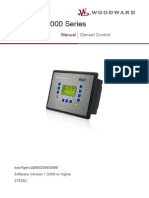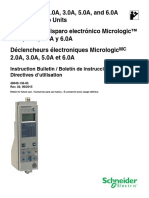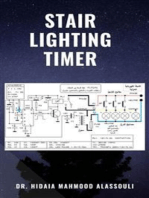100%(1)100% found this document useful (1 vote)
176 viewsEFC Familiarization
EFC Familiarization
Uploaded by
Ivan_UwaisThis document provides an overview of Cummins Electric Fuel Control (EFC) governors. It describes the components and functioning of EFC governors, including the magnetic pickup that senses engine speed, the governor control that compares speed to a preset point and adjusts fuel flow, and the actuator that controls fuel flow. It explains that EFC governors provide precise electronic control of engine speed without hydraulic components or linkage to the throttle shaft.
Copyright:
© All Rights Reserved
Available Formats
Download as PDF, TXT or read online from Scribd
EFC Familiarization
EFC Familiarization
Uploaded by
Ivan_Uwais100%(1)100% found this document useful (1 vote)
176 views21 pagesThis document provides an overview of Cummins Electric Fuel Control (EFC) governors. It describes the components and functioning of EFC governors, including the magnetic pickup that senses engine speed, the governor control that compares speed to a preset point and adjusts fuel flow, and the actuator that controls fuel flow. It explains that EFC governors provide precise electronic control of engine speed without hydraulic components or linkage to the throttle shaft.
Original Description:
EFC Familiarization
Copyright
© © All Rights Reserved
Available Formats
PDF, TXT or read online from Scribd
Share this document
Did you find this document useful?
Is this content inappropriate?
This document provides an overview of Cummins Electric Fuel Control (EFC) governors. It describes the components and functioning of EFC governors, including the magnetic pickup that senses engine speed, the governor control that compares speed to a preset point and adjusts fuel flow, and the actuator that controls fuel flow. It explains that EFC governors provide precise electronic control of engine speed without hydraulic components or linkage to the throttle shaft.
Copyright:
© All Rights Reserved
Available Formats
Download as PDF, TXT or read online from Scribd
Download as pdf or txt
100%(1)100% found this document useful (1 vote)
176 views21 pagesEFC Familiarization
EFC Familiarization
Uploaded by
Ivan_UwaisThis document provides an overview of Cummins Electric Fuel Control (EFC) governors. It describes the components and functioning of EFC governors, including the magnetic pickup that senses engine speed, the governor control that compares speed to a preset point and adjusts fuel flow, and the actuator that controls fuel flow. It explains that EFC governors provide precise electronic control of engine speed without hydraulic components or linkage to the throttle shaft.
Copyright:
© All Rights Reserved
Available Formats
Download as PDF, TXT or read online from Scribd
Download as pdf or txt
You are on page 1of 21
At a glance
Powered by AI
The document discusses the different types of engine governors including mechanical, mechanical/hydraulic, mechanical/electric/hydraulic, and fully electric governors. It also provides an overview of how an electric fuel control governor works in comparison to other governor types.
The different types of governors discussed are mechanical, mechanical/hydraulic, mechanical/electric/hydraulic, hydro-mechanical/electro-hydraulic combination, and fully electric governors.
An electric fuel control governor is a fully electric governor that controls engine speed electronically without any hydraulic components or linkages. It uses an electronic speed sensor, control box and electric actuator to precisely control fuel supply based on engine speed feedback.
Cummins
Electric Fuel Control Familiarization
Bulletin No. 3387370
1.
Electric Fuel Control Governor Familiarization
2. The purpose of this program is to familiarize
you with Cummins Electric Fuel Control
(EFC)…what it consists of, it’s purpose and how
it works.
3. An engine governor is a simple device that
helps maintain engine speed within the desired
limits, regardless of changes in load. A diesel
engine governor provides this control by
automatically changing the amount of fuel
supplied to the engine cylinders.
4. Several types of governors are available to
handle many different requirements, such as
desired reaction time, speed, and the degree of
precision. Governor types include Mechanical:
Mechanical/Hydraulic:
Mechanical/Electric/Hydraulic and finally, the
completely electric governors.
5. The mechanical Governor is driven by the
engine. A shaft and flywheel assembly moves
the throttle lever to maintain a relatively constant
engine speed, regardless of load.
6. As its name implies, the
Mechanical/Hydraulic Governor consists of
both mechanical and hydraulic components.
Like the Mechanical Governor, this one is
driven by the engine, and it consists of a shaft
and flywheel assembly.
7. However, this mechanical assembly controls
the position of a spool valve in a hydraulic
circuit. A gear pump supplies oil to the system
from the oil sump. Re-positioning the spool
valve changes the pressure in the circuit, which
moves a piston. Linkage between the power
piston and the throttle shaft allows the governor
to maintain the desired engine speed.
8. The third type of governor is not only
mechanical and hydraulic in nature, but includes
electrical circuitry as well. In this system the
electrical components position the spool valve in
the hydraulic circuit…again to move a power
piston linked to the throttle shaft. As you’ll see
later in the program, the electrical circuit
enhances the precision to control.
9. The fourth type of governor is a combination
of the Hydro-Mechanical and Electro-Hydraulic
Governors. The flyweights act as a backup
system in the event the electrical components
would fail.
10. The final type of governor on our list is the
completely electric governor. Regardless of
their manufacturer, all Electric Governing
systems are made up of an electronic speed
sensor, an electronic control box, and an
electric actuator.
11. In 1979 Cummins introduced its own, unique
version of a fully electric engine governor: the
Electric Fuel Control (EFC). Reliable, precise,
and unusually simple, it’s designed specifically
for Cummins engines with the PT fuel system. It
requires no linkage to the throttle shaft; nor does
it have any hydraulic components. Because it
requires a relatively small amount of hardware,
fewer adjustments are necessary, and installation,
maintenance and troubleshooting are simplified.
12. The EFC governor is compatible with Gen
Sets and certain other Industrial applications. It is
available in normally open or normally closed
versions. We’ll discuss these variations later in
the program.
13. The governing system consists of the
Magnetic Pick-up (MPU), which is mounted in
the flywheel housing, near the flywheel ring
gear. The MPU produces an alternating current
(A.C.) signal that is representative of engine
speed. This “speed” signal is transmitted to the
Governor Control.
14. The Governor Control compares the electric
signal from the magnetic pick-up with a preset
reference point. If there is a difference in the two
signals, the Governor Control will change the
current applied to the Actuator coil.
15.Any change in current in the Actuator coil
results in a change in the strength of an
electromagnet. This change causes the Actuator
shaft to rotate. Shaft rotation the controls fuel
flow to the engine through a rotary valve.
16. The MPU is an electro-magnetic device
that is mounted in the flywheel housing. It
operates on the principle of induced voltage.
(Refer to Bulletin No. 3379231-03 for
installation, adjustment and testing
procedures.).
17. Induced voltage is produced by “relative motion”
between a conductor and a magnetic field. To
illustrate, when a conductor is passed through a
magnetic field, deflection of the galvanometer
needle indicated that a voltage has been induced.
And, when we pass the conductor through the
magnetic field in the opposite direction, the
galvanometer needle is deflected again – but this
time in the opposite direction.
18. Now let’s hold the conductor in a stationary
position and move the magnetic field through the
conductor in each direction. Notice that we get the
same results that we saw when we passed the
conductor through the magnetic field. So we can see
that “relative motion” occurring between a magnetic
field and a conductor will induce voltage.
19. Now let’s apply this general concept of induced
voltage to the operation of the MPU. It consists of a
permanent-magnet core, wrapped with many turns of
fine copper wire. In a static situation, with no outside
influence, the magnetic lines of force traveling from
the North to the South poles are also static. Since no
relative motion exists between the magnetic lines of
force and the conductor (coil), no voltage is being
induced. Let’s see, then, how the moving ring gear
teeth influence the magnetic lines of force to, in effect,
cause the needed relative motion to occur between the
magnetic field and the conductor (coil).
20. Now let’s rotate the ring gear. As a tooth
approaches the magnetic field, it affords an easier path
for the lines of force to follow. Notice the deflection of
the lines as they pass through the tooth. These lines
never change in length. Therefore, the slight deflection
causes them to be drawn inward. As they pass through
the conductor (coil), a voltage begins to be induced.
Notice that, as the tooth gets closer to the MPU core, it
affects more and more lines of force. The lines continue
to move inward, increasing the amount of voltage being
induced.
21. Once the tooth is directly aligned with the
core, it is affecting the maximum number of
lines of force possible. At this moment, inward
movement of the lines of force is topped;
induced voltage, therefore, drops to zero.
22. As the tooth moves away from the core, it
affects fewer and fewer lines of force. Therefore,
the lines begin moving outward, toward their
original position. This outward movement results
in a voltage again being induced into the coil,
but in the opposite polarity.
23. Now the tooth passes entirely out of the
magnetic field…the lines of force have reached
their original position. They are static…no
voltage is being induced.
24. As the next ring-gear tooth approaches the
MPU, the same sequence of events occurs
again…the lines of force begin to move
inward, until
25. They reach their maximum inward travel.
Then
26. Outward again…
27. until once again they are “at rest”….
28. In the foregoing discussion, we’ve
established that the MPU, in conjunction with
the ring-gear teeth, generates a varying voltage
on a repeating basis. This results in an
alternating-current waveform. Let’s relate the
number of cycles generated… to a given period
of time.
29. Let’s assume that it takes one second for
each gear tooth to move past the MPU. The
passage of one gear tooth creates one cycle;
therefore, each tooth represents one cycle per
second.
30. Now let’s increase engine speed so that five
gear teeth move past the MPU in one second.
Since an increase in engine speed causes more
teeth to pass the MPU in one second, it is
apparent that a change in cycles generated per
second is directly related to a change in engine
speed.
31. Cycles per second is the unit of measure of
Frequency. Frequency simply refers to the
number of times a cycle occurs in one second.
Another way of referring to cycles per second
in “Hertz”. So one cycle per second equals one
Hertz; 1000 cycles per second equals 1000
Hertz.
32. During engine operation, variations in
Frequency are transmitted to the Governor
Control, where they’re interpreted as “actual
speed” signals.
33. Configurations of the Governor Control are
available to cover multiple applications. These
include remote-mounted and panel-mounted, and
those used with normally open or normally
closed actuators.
34. In addition to the “Actual Speed” signal from
the MPU, the Governor Control requires inputs
from the Droop Control, Gain Control, Run
Speed Control and the Idle Speed Control.
35. These controls are variable resistors,
commonly called Potentiometers, or “Pots”.
36. The Droop Adjustment is a one-turn Pot with
a range of 0% to approximately 5%.
37. Droop is the difference between no load and full
load speed, expressed as a percentage of full load speed.
In this graph we’ve plotted Frequency on the vertical
axis, and percent of load on the horizontal axis. The
diagonal line connects the no-load speed and the full-
load. This line is called the Droop Curve.
Notice that, for a given percent of load, there will
always be a corresponding speed between the no-load
and the full-load speed. When we subtract full-load
speed from no-load speed, and divide by the full-load
speed, we find that the Droop in our example is 3%.
38. This chart recording represents the speed of a
Droop-Governed engine under changing load conditions.
Between A and B, the recording line indicates a no-load,
steady state condition of 61.8 Hz. At point B, an
increase in load results in a decrease in speed. At point
C the governor reacts to the decreased in speed. At point
C the governor reacts to the decreased speed by
increasing fuel to the engine. Engine speed increases,
then, to a new, but lower, steady-state speed (point D).
Assuming that this governor is adjusted to a 3% speed
droop, we can see that the new steady-state speed of 60
Hz indicates that the unit is loaded to 100%.
39. The section of the line between B and D
indicates a changing speed condition. This is
referred to as a “Transient”. The time between
these points is called the “Response” time,
because it indicates the time it takes the governor
to return engine speed to a steady-state condition.
40. Most electric governors, including the EFC, are
capable of maintaining a constant, steady-state
speed, regardless of load, within the engines
capabilities. This is referred to as “Isochronous”
operation.
41. This time we’re indicating the speed of an
Isochronously-governed engine under changing load
conditions. Notice that, as before, an applied load
results in a decrease in speed between points B and C.
recovery by the governor begins at point C. Unlike a
Droop system, which would stabilize at some lower
speed, the Isochronous governor continues to correct
until it returns the engine to the original steady-state
speed, point D. The droop pot is set to “0” when
Isochronous operation is desired.
42. The Gain Adjustment is a one turn Pot. It
controls the response rate of the governor system
to speed changes, as a result of changes in load.
43. If the Gain Control is set too low
(counterclockwise) the response of the governor will
be too slow, as indicated in section 1 of this slide. In
section 2, we can see that if the Gain Adjustment is
set too high (clockwise), the response of the
governor will be too rapid, resulting in a speed
stability complaint.
44. The next control is the Idle Speed adjustment.
A 20-turn Pot is used to set Idle Speed. Rotating
the Pot clockwise increases Idle speed.
45. The Run Speed is a 20-turn Pot for setting
the desired no-load governed speed. A clockwise
rotation increases the run speed.
46. The Idle-Run switch allows the operator to
select either the idle or the run mode.
47. A remote adjust Pot is used on Gen Set
control panels to allow fine adjustments of the
Run Speed. Refer to Bulletin No. 3379231-03
for detailed information regarding all of the
controls and their proper adjustments.
48. We’ve explained that the MPU sends
information to the Governor Control in the form
of an “actual speed” signal. And we’ve discussed
the control Pots…how they’re adjusted to obtain
the desired Droop, Gain, Idle Speed , and Run
Speed.
49. The Governor Control, then, interprets all of
the input from the MPU and control Pots. Based
on these inputs, the Governor Control determines
the amount of current to be sent to the Actuator.
50. The Actuator is normally mounted in the
AFC/EFC cavity of the PTG/AFC fuel pump.
51. The Actuator consists of an electromagnetic
solenoid valve which, when energized, causes
the Actuator shaft to rotate.
52. In the Normally Open Actuator, the valve is
spring loaded to the open position. An increase in
current applied to the coil , moves the valve
toward the closed position.
In the Normally Closed Actuator, the valve is
spring loaded to the closed position. An increase
in current, therefore, will open the valve.
53. This is a Normally Closed Actuator. Notice
the fuel port in the shaft. You can see that, as the
shaft rotates, the alignment between the fuel port
and the fuel pump cavity is changed. This
alignment ranges between no fuel flow and
maximum fuel flow, the exact amount depending
on the amount of current the coil receives.
54. The rotating design results in a direct
relationship between the degree of Actuator shaft
rotation and engine HP output. In addition, it
ensures quick engine response to transient load
conditions.
55. If you’re familiar with the AFC, you can
readily see the similarity between it and the EFC
Actuator. Fuel from the fuel pump throttle shaft
enters the Actuator shaft. When the fuel port is
open, this fuel flows to the fuel solenoid valve
and on to the engine.
56. The Actuator is mounted in the AFC cavity
of the fuel pump. Notice that the ‘no-air” screw
is bottomed. With this condition, all of the fuel
leaving the mechanical governor must pass
though the Actuator before it flows to the fuel
solenoid valve.
57. Several styles of Actuators are available to cover
different fuel flow requirements, engine models and
battery voltages. Refer to Bulletin No. 3379231-03
for further information.
58. This is a simplified, single-unit, pictorial wiring
diagram of the basic EFC system.
1) Governor Control
2) Battery
3) MPU
4) Actuator
5) Speed Adjust Pot. (Instrument-panel mounted)
6) Idle Run switch
59. Notice the shield around the wiring between the
MPU and the Governor Control. This design helps to
reduce interference from outside sources, such as
radio transmissions, which tend to induce voltage.
This additional voltage can result in false input to
the Governor Control.
60. Now notice the Interwoven wires between the
Governor Control and the Actuator. Commonly
referred to as “Twisted Pairs”, this technique also
helps reduce electromagnetic interference. The
combination of a twisted pair of wires, within a
shield, provides maximum protection from
interference.
61. Several wiring configurations are necessary
because of the many applications for which the EFC
system is well suited. The diagrams range from the
relatively simple to the highly complex, like this one
for two gensets with a load-sharing control, EFC
governor, and an auto-synchronizing paralleling
system. For further information regarding wiring
diagrams and procedures, refer to Bulletin No.
3379231-03.
62. To summarize, the EFC system is one of the
simplest of all diesel engine electric governors. It
consists of the Magnetic Pick-Up (MPU), the
Governor Control, the Actuator and the related
wiring.
63. The MPU produces an Alternating Current (A.C.)
signal which represents engine speed. This signal is
then sent to the Governor Control.
64. The Governor Control contains adjustable
Potentiometers, or Pots, to set desired Droop, Gain,
Idle Speed and Run Speed. In addition, an Idle-Run
switch allows the operator to run the engine at idle
or at full RPM. When the Governor Control receives
the signal from the MPU, it interprets this input, plus
the inputs from the adjustable controls. It then
generated an output signal and changes the current
to the Actuator. If necessary.
65. The actuator consists of an electromagnetic valve
with a fuel port near one end. Depending on the
amount of current present in the coil, this port reduces
or increases fuel to the injectors. The result is that
engine speed remains within the desired limits,
regardless of the changes in load.
66. The final segment of our program deals with
troubleshooting electrical systems…such as the EFC.
Because detailed information concerning EFC
troubleshooting can be found in Bulletin No.
3379231-03, we’d like to offer some general
guidelines to aid establishing a logical and efficient
approach to troubleshooting any electrical system.
67. To aid in our discussing of these guidelines,
we’ve divided them into five general categories:
1) Gather information
2) Analysis the information
3) Perform tests
4) Re-test
68. In gathering information, it’s a good-idea—when
possible—to discuss the problem with the operator. For
example, if the engine was shut down automatically,
which, if any alarm indications were activated? Did he
hear any unusual noises?
69. Whenever possible, verify the information you’ve
received. For instance, because the adjustments on the
EFC are easily accessible, it’s possible that a pot may
have been misadjusted, regardless of information
given to the contrary.
70. Other likely sources of information include
visual inspections, operational checks when possible,
and a review of maintenance and service records.
71. These are only a few examples of information
sources. Obviously, as the systems become more
complex, more information will be required to
troubleshoot them successfully.
72. Information that has been gathered must be
analyzed in order to identify the most likely,
possible causes of the problem.
73. To properly analysis electrical problems, you
must have a good understanding of electrical
fundamentals and a thorough knowledge of the
electrical system in question, as well as related
systems. For example, symptoms that appear to be
governor related can actually be engine related.
Some examples are:
1) plugged fuel filter
2) high restriction in the return line
3) improper fuel pump calibration
4)restricted fuel supply fittings
74. Another definite asset would be your ability to
interpret wiring diagrams, and to use troubleshooting
charts, or “Trees”.
75. Ideally, your analyses will result in the
determination of a logical test sequence that will lead
to the isolation of the actual cause.
Some examples of tests include:
1) Check voltage at specified test points.
2) Check conductors for high resistance.
3) In some cases, substituting a “known-to-be-good”
component for a suspected malfunctioning
component is advisable.
76. When the tests you’ve performed point to the
cause of the problem, you can perform the
repair/replacement procedures with a high degree of
confidence.
77. However, if the cause has not yet been determined,
additional information-gathering and/or analysis and
testing are in order.
78. Once the repair/replacement has been made, you
must re-test the system to ensure that:
1) the problem is fixed
2) no additional problems exist, and
3) that the system is in the desired operating mode.
79. As you gain experience, these steps will become
”second nature” …they’ll require less and less thought.
However, this approach will mean little unless you
understand the system you’re troubleshooting! And the
better you understand it, the better will be your success
rate in troubleshooting the system.
You might also like
- ComAp Explanatory Dictionary GuideDocument34 pagesComAp Explanatory Dictionary GuideAdnan YakoobNo ratings yet
- QST30 GCS ConnectionsDocument5 pagesQST30 GCS ConnectionsOGNo ratings yet
- Cummins 2011 Test On A Kta50Document2 pagesCummins 2011 Test On A Kta50api-252499008No ratings yet
- 2.041 Woodward - EasyGen O&M PDFDocument69 pages2.041 Woodward - EasyGen O&M PDFJoséNo ratings yet
- Starters PDFDocument95 pagesStarters PDFmuhammad nazir100% (1)
- Cummins 4B3.9-G11 FR94625 enDocument5 pagesCummins 4B3.9-G11 FR94625 enTeodoro Cornelius AltuveNo ratings yet
- Amigo Manual CarritosDocument28 pagesAmigo Manual CarritosAnonymous ZtXb2RONo ratings yet
- Jeppview For Windows: List of Pages in This Trip KitDocument30 pagesJeppview For Windows: List of Pages in This Trip KitSamuel AlmecigaNo ratings yet
- Cummins Efc Valve PDFDocument5 pagesCummins Efc Valve PDFDavid Arbildo100% (1)
- Powercommand: Genset ControlsDocument9 pagesPowercommand: Genset Controlschock channel 19No ratings yet
- NPT11 Avr Mx341.mx321.ma325.ma327Document7 pagesNPT11 Avr Mx341.mx321.ma325.ma327Juan Jose Rodriguez100% (1)
- Manual enDocument80 pagesManual enBanyar AungNo ratings yet
- Dse 509Document2 pagesDse 509SOSNo ratings yet
- Electronic Governor CatalogDocument26 pagesElectronic Governor CatalogAung Mh100% (1)
- DYN110784 Technical BulletinDocument2 pagesDYN110784 Technical BulletinROBERTO CORONA GNo ratings yet
- DVR 2400 and DVR 2500 Digital Voltage Regulator: Installation, Operation and Maintenance ManualDocument68 pagesDVR 2400 and DVR 2500 Digital Voltage Regulator: Installation, Operation and Maintenance Manualalexel_unamNo ratings yet
- Woodward - Genset Controllers - Parallel Applications - EasYgen-2000 SeriesDocument2 pagesWoodward - Genset Controllers - Parallel Applications - EasYgen-2000 SeriestheloniussherekNo ratings yet
- ID FLX Lite 1.9 Reference GuideDocument149 pagesID FLX Lite 1.9 Reference Guideluisgomezpasion1No ratings yet
- Installation and Adjustments Manual Incorporating The Commissioning ProceduresDocument54 pagesInstallation and Adjustments Manual Incorporating The Commissioning ProceduresSimion Cosmin - AlinaNo ratings yet
- Dec3000 ControllerDocument4 pagesDec3000 ControllerSyed Mohammad NaveedNo ratings yet
- DSE5310 DSE5320 Data Sheet PDFDocument4 pagesDSE5310 DSE5320 Data Sheet PDFkikoNo ratings yet
- Generator Service KitDocument6 pagesGenerator Service KitKhaldoon Alnashi100% (1)
- Leroy Somer Tech DataDocument20 pagesLeroy Somer Tech DataMohamad Jado100% (2)
- 04-SnycLoadShare2015 DSEDocument35 pages04-SnycLoadShare2015 DSEJonathan BareñoNo ratings yet
- Interactive Schematic: This Document Is Best Viewed at A Screen Resolution of 1024 X 768Document17 pagesInteractive Schematic: This Document Is Best Viewed at A Screen Resolution of 1024 X 768Jose Corcega britoNo ratings yet
- S287 Fozmula Capacitance Coolant Level Switch Data JP 24 Nov 15 3.2 Rev 2Document1 pageS287 Fozmula Capacitance Coolant Level Switch Data JP 24 Nov 15 3.2 Rev 2Parinya0% (1)
- DSE Product Guide - IssuuDocument40 pagesDSE Product Guide - IssuuGONZALONo ratings yet
- Digital Avr For Alternators With Shunt, Arep or PMG ExcitationDocument2 pagesDigital Avr For Alternators With Shunt, Arep or PMG ExcitationParinyaNo ratings yet
- CDocument620 pagesCHung Cuong PhamNo ratings yet
- Stamford PI734FDocument8 pagesStamford PI734FTaz UddinNo ratings yet
- Dse8600 Series Dse Configuration Suite ManualDocument165 pagesDse8600 Series Dse Configuration Suite ManualGustavo Pereira100% (1)
- Cummins EFC Speed ControlDocument54 pagesCummins EFC Speed ControlRicharson Ochoa100% (2)
- Newage Mx341 Automatic Voltage RegulatorDocument6 pagesNewage Mx341 Automatic Voltage RegulatoredgarcooNo ratings yet
- DVR 2000eDocument101 pagesDVR 2000eDavid GoldenNo ratings yet
- BE2000E BrochureDocument4 pagesBE2000E BrochureOrlando VeladoNo ratings yet
- PMG PDFDocument6 pagesPMG PDFrajan_2002eeeNo ratings yet
- PCC 3201Document9 pagesPCC 3201386No ratings yet
- Speed Gov Wiring AdjustDocument1 pageSpeed Gov Wiring Adjustagus sumantriNo ratings yet
- Advanced Genset Controller: Installation InstructionsDocument22 pagesAdvanced Genset Controller: Installation InstructionsengjosewilkerNo ratings yet
- Olympain-R450 & R448 Avr Manuall PDFDocument7 pagesOlympain-R450 & R448 Avr Manuall PDFSayed Younis Sadaat100% (1)
- Wiring Smart Connect Genset MTUDocument55 pagesWiring Smart Connect Genset MTURudi sNo ratings yet
- Module 7 Fuel SystemDocument28 pagesModule 7 Fuel SystemAguilar AlexNo ratings yet
- Instruction ManualDocument30 pagesInstruction ManualsupriNo ratings yet
- Service Drawings: QSB7 Engine PlatformDocument31 pagesService Drawings: QSB7 Engine PlatformAmmar BaigNo ratings yet
- C10547058 PDFDocument28 pagesC10547058 PDFParinyaNo ratings yet
- ACS Analogue Control Systems eDocument12 pagesACS Analogue Control Systems eKhaled KamelNo ratings yet
- Gain Parameter ConfigurationDocument4 pagesGain Parameter Configurationlinkangjun0621No ratings yet
- 056-072 Dead Bus SyncDocument2 pages056-072 Dead Bus SyncYasser JaviNo ratings yet
- Mics Modys Manual EnuDocument11 pagesMics Modys Manual EnuRicardo Barajas GuerreroNo ratings yet
- B2-Lehe4748-01 - Emcp3.3Document8 pagesB2-Lehe4748-01 - Emcp3.3Ali H. Al-ZowayedNo ratings yet
- Woodward EasYgen Installation ManualDocument55 pagesWoodward EasYgen Installation ManualAlfred SitholeNo ratings yet
- Instructions For Use: Réf. Constructeur: Réf. GPAO: 33502012701 Ind1Document40 pagesInstructions For Use: Réf. Constructeur: Réf. GPAO: 33502012701 Ind1Lionel AuclairNo ratings yet
- Micrologic 2.0A PDFDocument154 pagesMicrologic 2.0A PDFGabriel ZorattiNo ratings yet
- SX440 SS440 ManualDocument4 pagesSX440 SS440 ManualThijsNo ratings yet
- ComAP Powermanagement Load Reserve Calculation - V3Document4 pagesComAP Powermanagement Load Reserve Calculation - V3Luis JesusNo ratings yet
- Installation and Operation Manual: Proact™ Itb Integrated Actuator and Throttle BodyDocument26 pagesInstallation and Operation Manual: Proact™ Itb Integrated Actuator and Throttle BodyNimNo ratings yet
- Product Information: Reference OnlyDocument4 pagesProduct Information: Reference OnlyOmarColonNo ratings yet
- ESD5100 Series Speed Control UnitDocument2 pagesESD5100 Series Speed Control Unitajcapetillog100% (2)
- Parallel Operation of AlternatorsDocument12 pagesParallel Operation of AlternatorsSharad Chougule100% (1)
- What Is Meant by A Load On A Generator? A Load On A Motor?Document9 pagesWhat Is Meant by A Load On A Generator? A Load On A Motor?I am Just TrollingNo ratings yet
- 14 AET - Remote MonitoringDocument12 pages14 AET - Remote MonitoringIvan_UwaisNo ratings yet
- 11 AET - Part 3 Installation Recommendations - 110906Document16 pages11 AET - Part 3 Installation Recommendations - 110906Ivan_UwaisNo ratings yet
- Mechanic People DevelopmentDocument18 pagesMechanic People DevelopmentIvan_UwaisNo ratings yet
- Organization System People Development-2018Document16 pagesOrganization System People Development-2018Ivan_UwaisNo ratings yet
- Modbus MappingDocument554 pagesModbus MappingIvan_UwaisNo ratings yet
- Generator Windings PitchDocument1 pageGenerator Windings PitchIvan_UwaisNo ratings yet
- Genset Log Book: Service Terakhir Service Kembali SignatureDocument3 pagesGenset Log Book: Service Terakhir Service Kembali SignatureIvan_UwaisNo ratings yet
- Table 130.5 (C) Likelihood Arc FIDocument1 pageTable 130.5 (C) Likelihood Arc FIIvan_UwaisNo ratings yet
- B20 - Presentation 2Document34 pagesB20 - Presentation 2Ivan_UwaisNo ratings yet
- Table 130.5 (G) EAM PPE SelectionDocument1 pageTable 130.5 (G) EAM PPE SelectionIvan_UwaisNo ratings yet
- Data Sheet Engine c550d5Document4 pagesData Sheet Engine c550d5Ivan_UwaisNo ratings yet
- Engine Troubleshooting ChartDocument1 pageEngine Troubleshooting ChartIvan_UwaisNo ratings yet
- The Green Hornet: "Wiggle Your Fingers Really Fast". Billy MayDocument18 pagesThe Green Hornet: "Wiggle Your Fingers Really Fast". Billy MayJo Grad100% (1)
- Chapter 17 Data Communication and Computer NetworksDocument57 pagesChapter 17 Data Communication and Computer NetworksAqib JavedNo ratings yet
- 50 Pet Sentence TransformationsDocument11 pages50 Pet Sentence TransformationsSusana Rojas LindeNo ratings yet
- English Task About TranscorpDocument9 pagesEnglish Task About TranscorpRizaludin HasanNo ratings yet
- Akai MPK Mini Play mk3 Bedienungsanleitung User Manual DE EN FR IT ESDocument28 pagesAkai MPK Mini Play mk3 Bedienungsanleitung User Manual DE EN FR IT ESSoy gilipollas yNo ratings yet
- The Boys StoryDocument7 pagesThe Boys StoryDaniel SousaNo ratings yet
- Mozart Power PointDocument15 pagesMozart Power Pointapi-253465341No ratings yet
- Minute Waltz - Opus 64 No. 1 in DB MajorDocument5 pagesMinute Waltz - Opus 64 No. 1 in DB MajorRhuanNo ratings yet
- Why Rap Music Should Be BannedDocument2 pagesWhy Rap Music Should Be BannedmokocagerNo ratings yet
- KellbessaDocument64 pagesKellbessatajudinNo ratings yet
- Kirk Whalum-Precious Lord Take My Hand-Tenor SaxDocument3 pagesKirk Whalum-Precious Lord Take My Hand-Tenor SaxHemkerovner Keresztszegh von Kolowrat-KrakowskyNo ratings yet
- Ampero II Stage - Effect List - EN - Firmware V1.0.4.1706584019966Document89 pagesAmpero II Stage - Effect List - EN - Firmware V1.0.4.1706584019966micheleNo ratings yet
- WHERE DO I BEGIN TAB by Slash at Ultimate-Guitar - Com 2Document1 pageWHERE DO I BEGIN TAB by Slash at Ultimate-Guitar - Com 2nicolle cortezNo ratings yet
- Contemporary Philippine Arts From The RegionsDocument6 pagesContemporary Philippine Arts From The RegionsaizaNo ratings yet
- Importance of Communication in EntertainmentDocument7 pagesImportance of Communication in EntertainmentPrithvi Sahni0% (1)
- Theory of Architecture ReviewerDocument51 pagesTheory of Architecture ReviewerlouiseNo ratings yet
- Electronic Music MachinesDocument367 pagesElectronic Music MachinesTaner ÖNGÜNNo ratings yet
- Kodaly Epigrames CBX-PFDocument4 pagesKodaly Epigrames CBX-PFcarcomalNo ratings yet
- Music Material Books, Poems and CDs To Support MusicDocument3 pagesMusic Material Books, Poems and CDs To Support Musicapi-3724678No ratings yet
- PSW250 PSW350 PSW450: Instruction ManualDocument20 pagesPSW250 PSW350 PSW450: Instruction ManualMarcelo De Viveiros CabeceirasNo ratings yet
- Seminar Project ProposalDocument23 pagesSeminar Project ProposalmulukenantuNo ratings yet
- Voodoo BrochureDocument2 pagesVoodoo BrochureshemarclarkeNo ratings yet
- Beethoven Pathetique Set Work Support GuideDocument7 pagesBeethoven Pathetique Set Work Support GuideCosmosandGlitterNo ratings yet
- Hewings Martin Haines Simon Grammar and Vocabulary For Advan 8Document4 pagesHewings Martin Haines Simon Grammar and Vocabulary For Advan 8tanyasomovaNo ratings yet
- EMC AND A: StandardsDocument40 pagesEMC AND A: StandardsKhởi NguyễnNo ratings yet
- (M9-GUIDE) Study Guide For DanceDocument5 pages(M9-GUIDE) Study Guide For DanceSean RosendoNo ratings yet
- Can-Can-T 5 RESUEL. DeysiDocument7 pagesCan-Can-T 5 RESUEL. DeysiDeysi CotrinaNo ratings yet
- Bossa Nova 32pDocument32 pagesBossa Nova 32pYMusicNo ratings yet





































































































